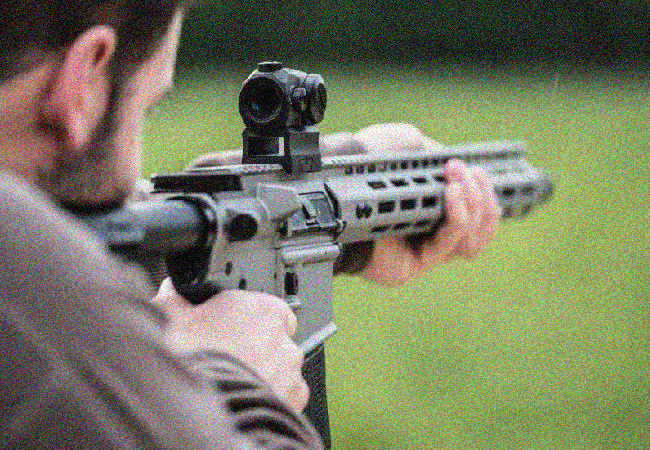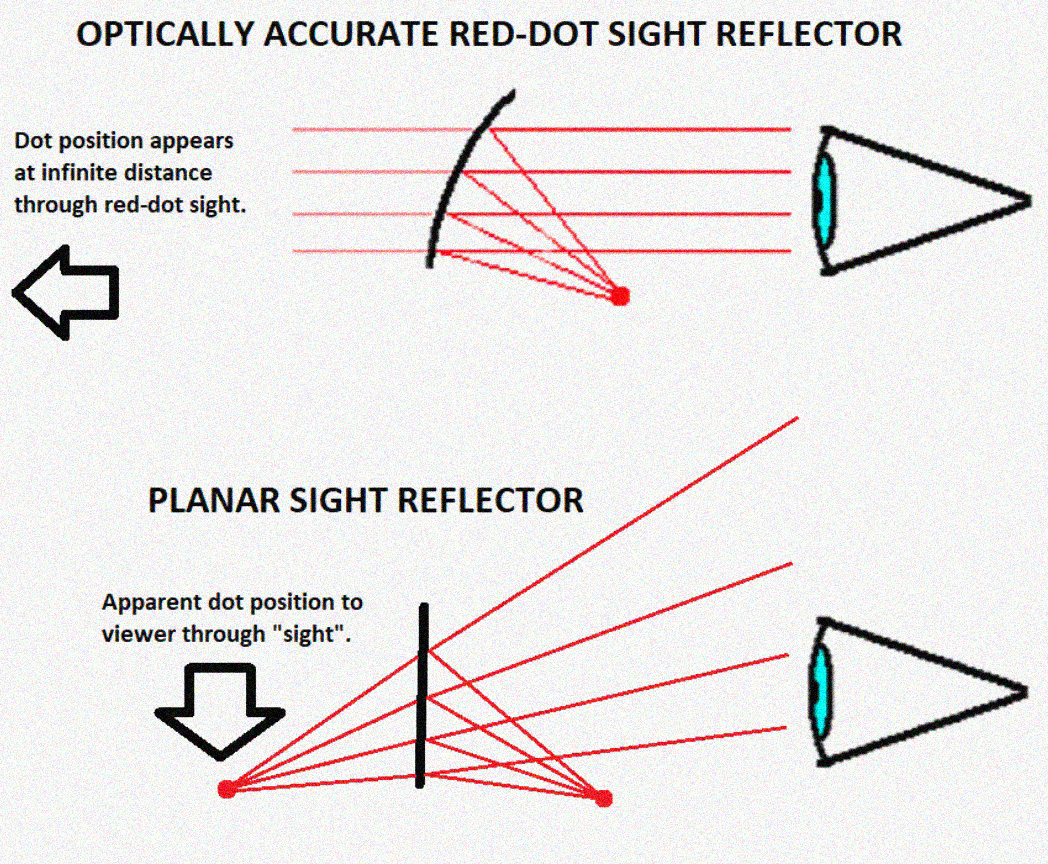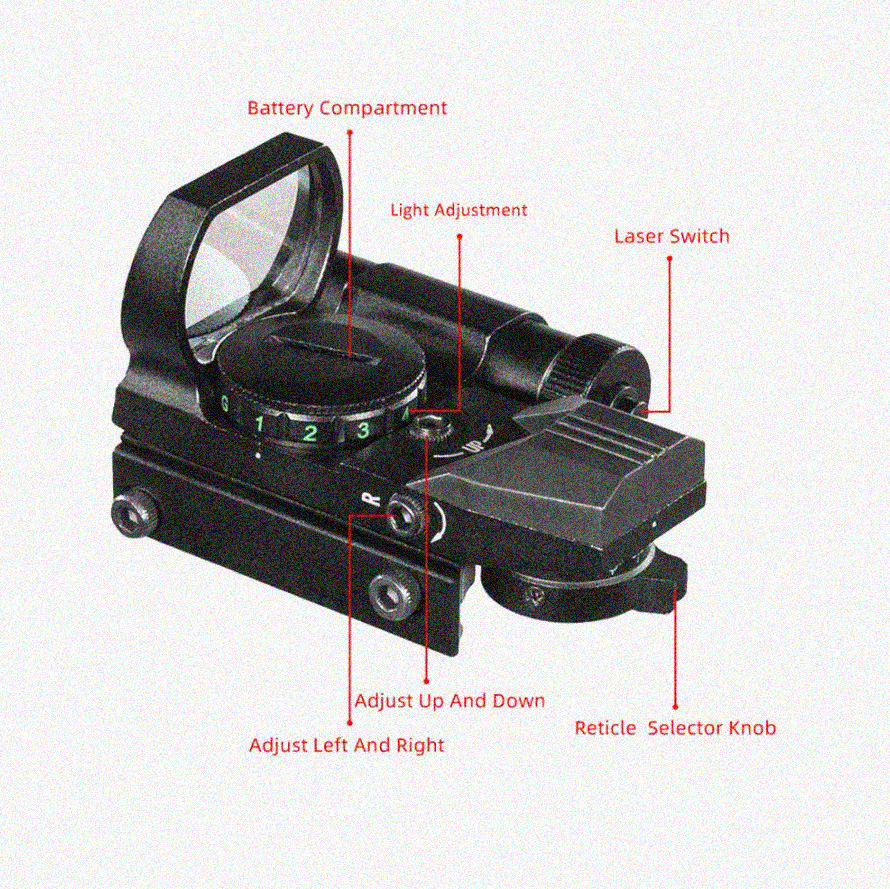A red dot sight is a type of optical sight that helps the user line up a shot by projecting a red dot onto the target. This designation comes from the fact that early red dot sights used an actual LED (light-emitting diode) to create the projected image. While LED sights are still available, most modern red dot sights use a miniature holographic projector to generate the reticle (the crosshair or aiming point).
How does this work?
The electronics in a holographic sight are fairly simple. There is a laser diode that emits a very narrow beam of light. This beam is passed through a series of lenses and mirrors which transform it into a plane wave. The plane wave then hits a semi-transparent mirror, which reflects some of the light while allowing the rest to pass through.
The light that passes through the semi-transparent mirror is projected onto a holographic reticle that is recorded on a thin film inside the sight (this is why they are sometimes referred to as “holographic sights”). The reticle is illuminated by the laser diode and appears as a red dot in the sight window. When looking through the sight, the user sees the red dot superimposed on the target.
One advantage of using a holographic reticle is that it can be easily seen against any background, even in low light conditions. This makes it ideal for use in tactical situations where quick target acquisition is critical. Additionally, because the reticle is recorded on a film, it can be designed to incorporate multiple aiming points or even moving targets.
Red dot sights are not without their drawbacks, however:
- One is that they can be tricky to align properly since the red dot must be lined up with the target for the shot to be accurate.
- Additionally, because they use a laser diode to create the reticle, they can be subject to “blooming” when used in very bright light conditions. This is where the projected dot appears fuzzy and enlarged, making it more difficult to use for precision aiming.
- Finally, holographic sights can be relatively expensive, with some models costing several hundred dollars.
Despite these drawbacks, red dot sights remain popular among shooters for their quick target acquisition and ease of use. If you are considering adding one to your collection, be sure to do your research to find the model that best fits your needs.
A red dot sight is a type of optical sight that helps the shooter align the weapon with the target. It projects a red dot onto the target, and the shooter simply has to line up the red dot with the target. Red dot sights are becoming increasingly popular, as they allow for more accurate shooting without having to deal with alignment issues.
How do red dot sights work?
Red dot sights work by projecting a single red dot onto the target. The shooter then lines up the red dipole with the front and rear sight posts which makes it easy to find and engage targets accurately. Most models have four different brightness settings for poor light conditions or against different color backgrounds. Dot size also varies on some models from 2-4 MOA (minutes of angle), which is the size of the dot at 100 yards.
What are the benefits of using a red dot sight?
There are several benefits to using a red dot sight. First, it makes it easier to shoot accurately as you do not have to align the front and rear sight posts. Second, it is easier to find and engage targets as the red dot is easy to see. Third, most models have four different brightness settings, so you can still use the sight in poor light conditions or against different color backgrounds. Finally, some models have a larger dot size, which can be helpful for shooters with vision problems.
What are the disadvantages of using a red dot sight?
There are a few disadvantages to using a red dot sight. First, they can be more expensive than traditional iron sights. Second, they require batteries, so if the batteries die, you will not be able to use the sight. Third, they can be damaged if dropped or hit hard. Finally, some people find them difficult to use in low light conditions.
A red dot sight is a type of firearm sight that uses an illuminated red dot as an aiming reticle.
Red dot sights are becoming increasingly popular on pistols, shotguns, and rifles as they offer several advantages over traditional iron sights.
1. Red dot sights allow for quicker target acquisition. This is because the red dot is superimposed over the target, making it easier to align the gun with the target.
2. Red dot sights also have unlimited eye relief, meaning that you can position your eye anywhere behind the sight and still see the red dot. This makes them much more comfortable to use for extended periods than iron sights.
3. Many shooters find that red dots simply look cooler than iron sights!
A red dot sight is a type of optical gun sight that uses a red dot as its aiming reticle. Red dot sights are designed to improve shooting accuracy by making it easier for the shooter to align the gun with the target.
There are a few different types of red dot sights on the market, but they all generally work in the same way. The red dot is placed in the center of the sighting system’s optics, and when aligned with the target, it helps the shooter to take accurate aim.
Red dot sights can be used on both handguns and long guns, and they are becoming increasingly popular among shooters of all skill levels. Many red dot sights also offer additional features like magnification or night vision, which can further improve shooting accuracy.
A red dot sight works by using a small red dot that is reflective and projects onto a piece of glass in the sight. The glass will then magnify the image of the red dot, making it easier for you to see.
A red dot sight is great for use on handguns, shotguns, and carbines because they provide a clear and concise aiming point. You can also get red dot sights that have an adjustable brightness level, which can be helpful in different light conditions. Another advantage of a red dot sight is that they tend to be less expensive than some other types of sights.
The main disadvantage a red dot sight is that they can be difficult to see in low light conditions. If you plan on using your red dot sight in dim or dark conditions, you may want to consider a different type of sight.
Please login or Register to submit your answer





